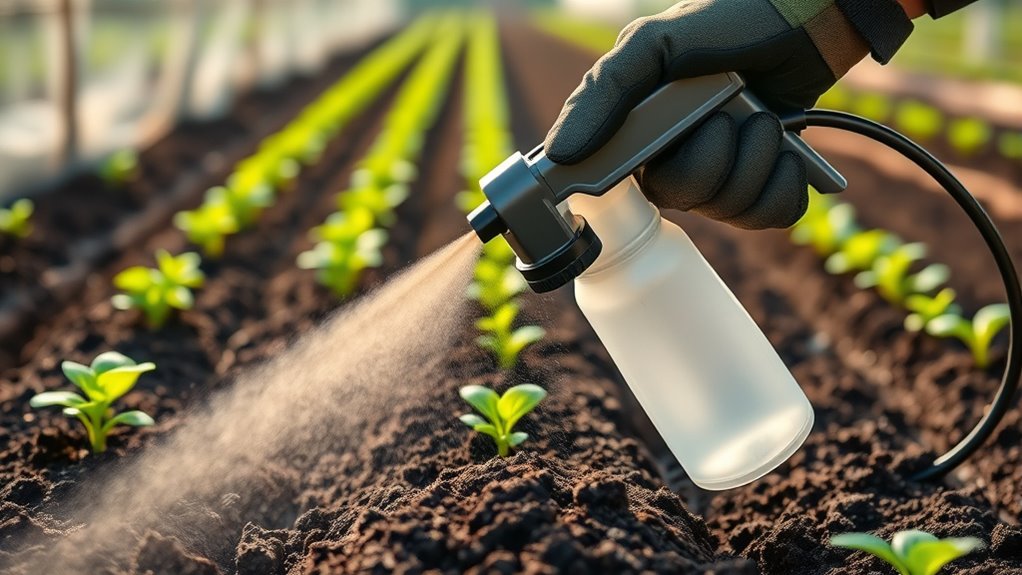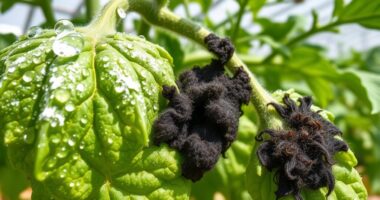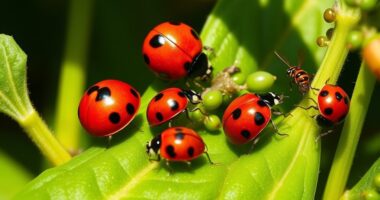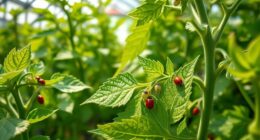To tackle diseases at the root, soil sterilization clears harmful pathogens, weeds, and pests, giving your plants a healthy start. You can choose chemical fumigation for quick, broad-spectrum results or biological methods that boost long-term soil health naturally. Combining both approaches can often provide the best outcomes, especially for large or urgent projects. If you want to learn more about effective sterilization techniques and tips, there’s plenty more to explore.
Key Takeaways
- Soil sterilization eliminates pathogens, weeds, and pests, creating a healthy environment for plant growth.
- Chemical fumigation provides rapid, thorough sterilization suitable for large-scale agricultural needs.
- Biological control introduces beneficial organisms to suppress harmful soil diseases naturally and sustainably.
- Combining chemical and biological methods can optimize soil health and disease management effectively.
- Proper method selection depends on crop type, environmental impact, and long-term soil health goals.
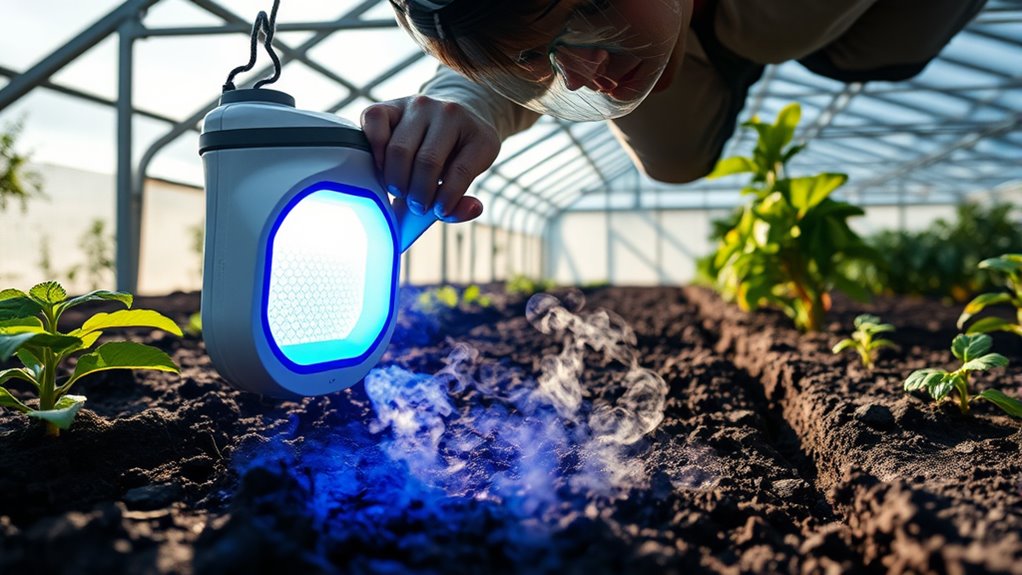
Soil sterilization is a critical process for eliminating harmful pathogens, weeds, and pests from soil to create a clean environment for planting. When you want to guarantee healthy crop growth, it’s essential to start with soil that’s free from threats that can compromise your plants. Two common methods used are chemical fumigation and biological control, each offering unique advantages depending on your needs.
Chemical fumigation involves applying specific chemicals to the soil to eradicate a broad spectrum of soil-borne pathogens, nematodes, and weed seeds. These chemicals, such as methyl bromide or chloropicrin, penetrate the soil quickly and deliver fast results. You should handle these substances with care, following safety protocols, as they can be hazardous to humans, animals, and the environment if misused. Chemical fumigation is especially effective for large-scale agricultural operations where total sterilization is necessary before planting. It’s a dependable way to quickly reset the soil, but it’s also important to consider the potential environmental impact and regulatory restrictions associated with chemical use.
Chemical fumigation uses powerful chemicals for rapid, broad-spectrum soil sterilization, but requires careful handling and environmental considerations.
On the other hand, biological control offers a more sustainable and eco-friendly approach. Instead of chemicals, you introduce beneficial microorganisms, fungi, or natural predators into the soil to suppress harmful pathogens and pests. You might use specific strains of bacteria or fungi that outcompete or inhibit disease-causing organisms. Biological control is excellent for organic farming or situations where chemical residues are a concern. It promotes a balanced soil ecosystem, leading to healthier plants over time. While it may require more time to see results compared to chemical fumigation, biological control enhances soil vitality and resilience, reducing the risk of future infestations.
Deciding between chemical fumigation and biological control depends on your goals, crop type, and environmental considerations. Chemical methods deliver quick, thorough sterilization, making them suitable for urgent situations or large-scale operations. Biological control, however, emphasizes sustainability, soil health, and long-term pest management. You might even combine these approaches, using chemical fumigation to initially sterilize and biological methods to maintain soil health afterward.
Ultimately, understanding your soil’s specific needs and the ecosystem involved will guide your choice. Both chemical fumigation and biological control play essential roles in soil sterilization, helping you create an ideal environment for your plants to thrive. By carefully selecting and implementing these methods, you guarantee your soil remains productive, healthy, and free from persistent threats. Effective sterilization techniques are key to establishing a thriving garden or farm.
Frequently Asked Questions
How Long Does Soil Sterilization Effects Last?
The effects of soil sterilization typically last from a few weeks to several months, depending on the sterilization protocol you use. Soil residue from sterilization can diminish over time as beneficial microbes re-establish. To maximize results, follow proper sterilization protocols carefully, ensuring you target all contaminated areas. Keep in mind, recontamination can occur, so regular monitoring and possible re-sterilization may be necessary to maintain disease-free soil.
Can Soil Sterilization Harm Beneficial Microorganisms?
You might wonder if soil sterilization harms beneficial microorganisms. It can disrupt the microbial balance, temporarily reducing beneficial microbes that support plant health. However, soil resilience usually allows beneficial organisms to recover over time. To minimize harm, consider sterilization methods that target pathogens specifically, and reintroduce beneficial microbes afterward to help restore the soil’s natural microbial community and promote healthy, resilient soil for future growth.
Is Soil Sterilization Suitable for Organic Farming?
Like a double-edged sword, soil sterilization can threaten organic farming by disrupting the soil nutrient balance and beneficial microorganisms. While it effectively reduces pests and diseases, it may also eliminate helpful microbes that support plant growth. Organic farming emphasizes natural pest resistance strategies and maintaining soil health, making sterilization less suitable. Instead, focus on composting, crop rotation, and biological controls to nurture healthy, resilient soil.
What Are Eco-Friendly Alternatives to Chemical Sterilization?
If you’re looking for eco-friendly alternatives to chemical sterilization, consider biodegradable methods like solarization or organic mulches. These techniques effectively reduce soil pathogens while being environmentally friendly. You can also use natural suppressants, such as neem oil or compost teas, to boost soil health. These options help control diseases naturally, supporting sustainable farming practices without harming the ecosystem or beneficial soil organisms.
How Does Soil Sterilization Impact Crop Yield?
Soil sterilization can substantially impact your crop yield by temporarily reducing soil health and microbial diversity. While it helps eliminate pests and diseases, it may also kill beneficial microbes that support plant growth. This can lead to lower nutrient availability initially. However, if managed carefully, you can restore microbial diversity over time, ultimately improving soil conditions and boosting your crop productivity in the long run.
Conclusion
Now that you know how soil sterilization can effectively tackle plant diseases at their source, aren’t you enthusiastic to try it in your garden? Imagine healthy, thriving plants growing where once harmful pathogens lurked. By sterilizing your soil, you’re giving your garden a fresh start and a healthier future. So, why not take that step today and turn your soil into a disease-free haven? Your plants—and your green thumb—will thank you.
